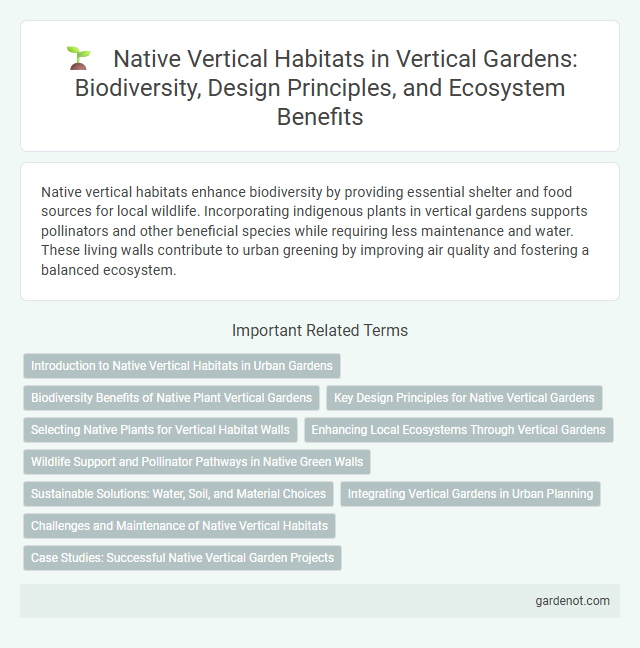Native vertical habitats enhance biodiversity by providing essential shelter and food sources for local wildlife. Incorporating indigenous plants in vertical gardens supports pollinators and other beneficial species while requiring less maintenance and water. These living walls contribute to urban greening by improving air quality and fostering a balanced ecosystem.
Introduction to Native Vertical Habitats in Urban Gardens
Native vertical habitats transform urban gardens by integrating indigenous plants that support local biodiversity and enhance ecological resilience. These habitats create layered green spaces that improve air quality, reduce urban heat, and provide crucial shelter and food sources for native pollinators and birds. Incorporating native species in vertical garden designs fosters sustainable urban ecosystems that require less maintenance and promote environmental balance.
Biodiversity Benefits of Native Plant Vertical Gardens
Native plant vertical gardens enhance urban biodiversity by creating habitats that support local pollinators, birds, and beneficial insects. These vertical ecosystems improve air quality and promote ecological balance through native flora's adaptability and resilience. Incorporating species native to the region boosts genetic diversity and strengthens urban green infrastructure against environmental stressors.
Key Design Principles for Native Vertical Gardens
Key design principles for native vertical gardens emphasize selecting indigenous plant species that thrive in vertical environments, ensuring ecological compatibility and promoting biodiversity. Proper irrigation systems and substrate composition are crucial for maintaining moisture balance and supporting root health in vertical structures. Incorporating natural pest control methods and maximizing sunlight exposure optimize growth and sustainability within native vertical habitats.
Selecting Native Plants for Vertical Habitat Walls
Selecting native plants for vertical habitat walls enhances biodiversity by providing essential food and shelter for local pollinators and wildlife. Native species such as ferns, mosses, and perennial wildflowers adapt well to vertical structures, requiring less maintenance and improving ecological resilience. Incorporating region-specific flora optimizes moisture retention and temperature regulation, supporting sustainable urban greening efforts.
Enhancing Local Ecosystems Through Vertical Gardens
Native vertical habitats use indigenous plant species to create vertical gardens that support pollinators, birds, and beneficial insects. These installations improve urban biodiversity by providing refuge and food sources within dense cityscapes. Integrating native flora into vertical gardens enhances local ecosystems by restoring natural habitats and promoting ecological balance.
Wildlife Support and Pollinator Pathways in Native Green Walls
Native vertical habitats in green walls provide essential wildlife support by creating continuous pollinator pathways that foster biodiversity in urban environments. These native plant species attract and sustain local pollinators such as bees, butterflies, and birds, enhancing ecological connectivity and promoting natural pest control. Integrating native flora into vertical gardens strengthens urban ecosystems and boosts habitat resilience against environmental stressors.
Sustainable Solutions: Water, Soil, and Material Choices
Native vertical habitats prioritize sustainable solutions by utilizing drought-tolerant plants adapted to local climates, reducing water consumption through efficient irrigation systems such as drip or capillary mats. Soil selection focuses on lightweight, nutrient-rich substrates that promote healthy root growth while minimizing environmental impact. Eco-friendly materials like recycled plastics, bamboo, and natural fibers support long-lasting structures that blend seamlessly with native ecosystems and reduce overall carbon footprints.
Integrating Vertical Gardens in Urban Planning
Integrating vertical gardens into urban planning enhances biodiversity by creating native vertical habitats that support local flora and fauna. These living walls improve air quality, reduce urban heat island effects, and optimize space in densely populated areas. Strategic incorporation of native plant species in vertical gardens fosters ecological resilience and promotes sustainable city development.
Challenges and Maintenance of Native Vertical Habitats
Native vertical habitats face challenges such as limited soil depth, water retention difficulties, and exposure to wind and sun, which stress plant survival. Maintenance requires regular irrigation management, pruning to prevent overgrowth, and monitoring for pests and diseases specific to native species. Selecting appropriate native plants adapted to vertical conditions reduces maintenance efforts and enhances habitat resilience.
Case Studies: Successful Native Vertical Garden Projects
Native vertical garden projects demonstrate ecological benefits by using indigenous plant species that support local wildlife and enhance biodiversity. Case studies such as the City of Melbourne's urban vertical forest and Singapore's Changi Airport showcase innovative designs integrating native flora for improved air quality and urban cooling. These projects reveal increased pollinator activity and reduced maintenance needs, validating the sustainability of native vertical habitats in urban settings.
Native vertical habitat Infographic

 gardenot.com
gardenot.com